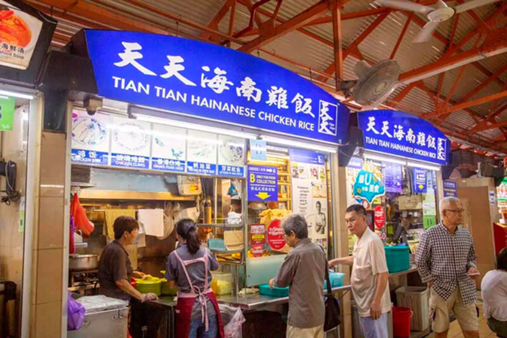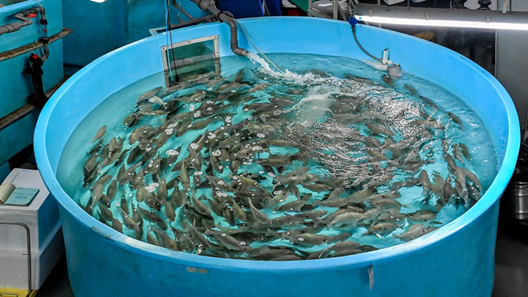The role of Marine Aquaculture in Singapore’s Food Security
- tembusuasiamedia
- Jun 10, 2022
- 6 min read
Updated: Jun 23, 2023
Jun 10, 2022

Disruption of food imports On 1st June 2022, Malaysia halted the export of 3.6 million chickens per month to Singapore to address rising prices and the domestic shortage of chickens, causing panic amongst many in Singapore, as a third of our chicken supplies come from Malaysia. Due to this, eateries and wet market stallholders were hit hardest by the export ban, with chicken sellers already facing a 20 to 70 per cent chicken shortage, as reported by Channel News Asia in May 2022. By the time the export ban started, prices for whole chickens, chicken parts, and chicken dishes in hawker centres had already increased across the board. News like this may seem unexpected, given how Singapore is known for its preparedness and foresight on meeting citizen’s basic needs and demands, but it only remind us on the vulnerability of Singapore to food shortages, being a land-scarce island.

Figure 1. Stalls selling Singapore’s national dish, Hainanese Chicken Rice, were affected (Unscrambled, 2022)
The chicken shortage is not the only food security crisis that Singapore faces at the moment. The cost of fish from Malaysia has increased as well, partially due to increased fuel prices. The more concerning fact pertaining to this issue is that fish sightings have also been dropping in recent months, with Malaysian fishermen estimating decreases in fish sightings by 15 to 30 per cent. For example, fish landings that used to be at 4,000 metric tonnes per day, have landed only at 3,250 tonnes per day in the last week of May. As Malaysia supplied 25 per cent of Singapore’s seafood in 2021, it will be no surprise should the fish shortages in Malaysia result in shortages in Singapore as well.
Importance of local food produce Such disruptions in food imports, coupled with the ramifications of climate change, have placed even more emphasis on increasing the food security in Singapore. With our meat being supplied by countries as far as Brazil, our rice from Thailand and India, and our vegetables from all over the world, it is almost certain that the chicken and fish import disruptions from Malaysia will not be our last. Therefore, there is an urgent need to reduce our reliance on imports and increase local food production. In light of this, the Singapore Food Agency (SFA) launched a ‘30 by 30’ goal in 2019 with the objective to produce 30 per cent of the nation’s nutritional needs locally and sustainably by 2030. In such uncertain times, local produce is essential to serve as buffers during any supply chain disruptions. As of 2021, SFA has reported that we are producing less than 10 per cent domestically. Hence, there is still room for continued growth and expansion in the local food industry.

Role of domestic marine aquaculture One important sector in the local food industry is marine aquaculture. According to a study mentioned in an article by TODAY, marine aquaculture “is one of the most efficient sectors available for production of animal proteins”. As compared to other forms of livestock farming, such as beef, pork and poultry, marine aquaculture is more cost-effective in converting feed into protein for human consumption. In addition, the operations are more sustainable as they typically involve a smaller carbon footprint and require less land and fresh water. As such, domestic seafood production is indeed vital in our progress towards the city-state’s ‘30 by 30’ vision. For example, the constant production of food by local fish farms was able to minimise the impacts of a two-week closure of the Jurong Fishery Port (JFP) in July 2021.

Figure 3. Local fish farm on Singapore’s waters (SFA, n.d.)
To support the expansion of a robust domestic aquaculture industry, SFA has created a Singapore Aquaculture Plan which will further boost our sea-based fish farming capabilities. Measures include the introduction of temporary occupation licences (TOL), which makes fish farming more affordable and attractive to newcomers and current farmers alike. New sea spaces are being unlocked in the Southern Waters and East Johor Strait, with long lease periods to let companies and fish farmers make long-term investments and commitments. Furthermore, annual licence fees are being lowered from 1 Jan 2023 onwards, in addition to the $60 million Agri-Food Cluster Transformation Fund available to fish farmers to adopt new technology, innovate, and upgrade their farming practices. Beyond financial aid, the government is also supporting the research and development of sustainable aquaculture practices and solutions. The Marine Aquaculture Centre (MAC) on St John’s Island, which is operated by SFA, conducts research into hatchery technology, aquaculture nutrition, and aquatic husbandry. MAC also partners with local universities and polytechnics to create new solutions that improve efficiency and yields of fish farms. An example is the development of new breeds of Asian seabass that grow quickly and are resistant to disease.
Adoption of sustainable marine aquaculture practices Research has already produced viable sustainable aquaculture practices. Blue Ocean Aquaculture Technology (BOAT) has developed a factory-based recirculating aquaculture system (RAS) that allows for indoor fish farming, which means that fish farming does not need to be sea-based anymore. As for fish farming on the sea, Aquaculture Centre for Excellence has developed a floating closed-container system that reduces the environmental impacts of fish farms and protects fish from adverse environmental conditions. A separate floating closed-container system has also been developed by EcoArk, which incorporates RAS and green energy for a sustainable fish farming solution.

Figure 4. Fish being raised in a tank in BOAT’s RAS system (SFA, 2022).
Some of these new practices are recent developments, but others have already proven to be very effective. Barramundi Group, a local fish farming company, was the first company to secure a 4-star Best Aquaculture Practices rating in both Singapore and Australia. This means that their farmed seafood was sustainably produced at all levels, which includes hatchery operations, fish feed production, and processing of harvested fish. Barramundi Group is now working with WWF-Singapore to implement further plans that will qualify them for Aquaculture Stewardship Council certification, which will recognise them as world-class sustainable fish farmers.
Environmental impacts of marine aquaculture These sustainable practices are needed as traditional aquaculture farms can negatively impact marine ecosystems in various ways. For instance, excess nutrients that enter the water via feed or waste could result in algae blooms, and the construction of pilings to keep the fish farm in place could destroy coral reefs. Nutrient depletion could also affect marine organisms that require good water quality and light penetration to thrive, such as giant clams. Endangered species are at risk as well. Singapore is not only part of the coral triangle, but also contains intertidal habitats such as sandy shores, rocky shores, mangrove forests and seagrass meadows. These habitats are home to a variety of native marine megafauna species like the critically endangered hawksbill turtle and the endangered green sea turtle. As such, keeping the waters clean is another reason to turn away from traditional aquaculture operations that might threaten the rich biodiversity and marine ecosystems in Singapore’s waters.

Figure 5. Critically endangered hawksbill turtle (U.S. Fish and Wildlife Service Southeast Region, 2011)
The Way Forward In TEMBUSU Asia Consulting (TAC), we believe that with proper assessments and measures put in place, the negative impacts of fisheries can be. In addition, TAC has been actively involved in urban resilience projects, of which one aspect is food security. TAC partnered with subject matter experts to assessing the coastal hydrodynamics and modelling the movement of water-borne pathogens to assess the water quality of the potential sites. This eventually aims to improve the reliability of local fish farms and elevate the food security in Singapore. Ultimately, the expansion of sustainable aquaculture is vital to increasing food security in a changing environment. With our efforts, TAC hopes to contribute to enhancing the sustainability and resilience of food supply in Singapore.
References Ang, R. (2021, September 29). S’pore fish farm to aim for highest sustainable farming standards in aquaculture. The Straits Times. https://www.straitstimes.com/singapore/environment/spore-fish-farm-to-aim-for-highest-sustainable-farming-standards-in Baker, A. (2022, May 26). Chicken shortage at some Singapore wet markets ahead of Jun 1 Malaysia export ban. CNA. https://www.channelnewsasia.com/singapore/wet-market-chicken-seller-supply-shortage-malaysia-export-ban-2708901 Best Aquaculture Practices. (n.d.). Best Aquaculture Practices. Best Aquaculture Practices. https://www.bapcertification.org/OurLogo Lee, L., & Low, Y. (2022, May 23). Fish farms may be set up near 3 southern islands with high coral diversity, endangered marine life; public feedback underway. TODAY. https://www.todayonline.com/singapore/sfa-feedback-fish-farming-islands-1904801 Lim, K., & Lee, L. (2022, May 26). ‘Never seen prices like this’: Fish, chicken stallholders fret over passing on higher costs to customers. Today Online. https://www.todayonline.com/singapore/chicken-fish-stallholders-fret-passing-higher-price-customers-1908961 Malaysia to halt export of 3.6 million chickens a month from June 1 to address domestic shortage, rising prices. (2022, May 23). TODAY. https://www.todayonline.com/world/malaysia-halt-export-36-million-chickens-month-june-1-address-domestic-shortage-rising-prices-1905231 National Oceanic and Atmospheric Administration (NOAA). (2020, September 30). Aquaculture Supports a Sustainable Earth | NOAA Fisheries. NOAA Fisheries. https://www.fisheries.noaa.gov/feature-story/aquaculture-supports-sustainable-earth Razali, N. A. (2022, May 4). Singapore’s challenging 2030 food security goals underlined by new production data. Food Navigator Asia. https://www.foodnavigator-asia.com/Article/2022/05/04/singapore-s-challenging-2030-food-security-goals-underlined-by-new-production-data Singapore Food Agency (SFA). (n.d.). The Singapore Aquaculture Plan. Our Food Future. https://www.ourfoodfuture.gov.sg/uplifting-aquaculture-industry/sg-aquaculture-plan Singapore Food Agency (SFA). (n.d.). 30 by 30. Our Food Future. https://www.ourfoodfuture.gov.sg/30by30 Singapore Food Agency (SFA). (2022, February 28). Singapore poised to be hub for tropical aquaculture technology. Singapore Food Agency. https://www.sfa.gov.sg/food-for-thought/article/detail/singapore-poised-to-be-hub-for-tropical-aquaculture-technology Singapore Food Agency (SFA). (2022, March 7). Strengthening Singapore’s Food Security Through Sustainable and Productive Aquaculture. Media Release. https://www.sfa.gov.sg/docs/default-source/default-document-library/20220307-cos-2022—media-release-on-aquaculture-plan.pdf Singapore Food Agency (SFA). (2022, March 31). SFA | Agri-food Cluster Transformation (ACT) Fund. Singapore Food Agency. https://www.sfa.gov.sg/food-farming/funding-schemes/act-fund Yusof, A., & Tan, V. (2022, May 31). CNA Explains: What’s behind rising fish prices in Malaysia? CNA. https://www.channelnewsasia.com/asia/cna-explains-malaysia-fish-price-hike-supply-problem-weather-labour-2718431 Yusof, A., & Tan, V. (2022, May 31). Weather, labour shortage affect fish supply in Malaysia, say industry players as prices go up. CNA. https://www.channelnewsasia.com/asia/malaysia-fish-supply-weather-labour-shortage-price-hike-2717796






Comments